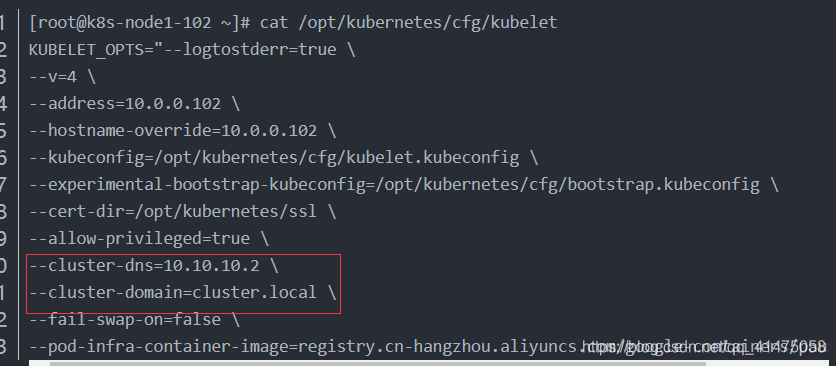
一、环境变量
创建pod资源时,kubelet会将其所属名称空间内的每个活动的Service对象以一系列环境变量的形式注入其中。
1、创建一个service匹配标签为之前创建的pod的标签app:nginx,映射80和443端口
vim service.yaml
[root@k8s-master-101 yaml_test]# cat service.yaml
apiVersion: v1
kind: Service
metadata:
name: my-service
spec:
ports:
- name: http
protocol: TCP
port: 80
targetPort: 80
- name: https
protocol: TCP
port: 443
targetPort: 443
selector:
app: nginx
#创建service
[root@k8s-master-101 yaml_test]# kubectl create -f service.yaml
service/my-service created
2、查看service和endpoints
[root@k8s-master-101 yaml_test]# kubectl get svc
NAME TYPE CLUSTER-IP EXTERNAL-IP PORT(S) AGE
kubernetes ClusterIP 10.10.10.1 <none> 443/TCP 19d
my-service ClusterIP 10.10.10.164 <none> 80/TCP,443/TCP 15m
[root@k8s-master-101 yaml_test]# kubectl get ep
NAME ENDPOINTS AGE
kubernetes 10.0.0.101:6443 19d
my-service 172.17.50.2:80,172.17.50.3:80,172.17.71.5:80 + 5 more... 2m39s
3、创建一个busybox。
vim busybox.yaml
[root@k8s-master-101 yaml_test]# cat busybox.yaml
apiVersion: v1
kind: Pod
metadata:
name: busybox
namespace: default
spec: containers:
- image: busybox:1.28.2
command:
- sleep
- "3600"
imagePullPolicy: IfNotPresent
name: busybox
restartPolicy: Always
4、创建pod,进入容器然后查看系统变量
可以看到系统变量中有刚才创建的my-service的ip相关信息
[root@k8s-master-101 yaml_test]# kubectl create -f busybox.yaml
pod/busybox created
[root@k8s-master-101 yaml_test]# kubectl exec -it busybox sh
/ # env
KUBERNETES_SERVICE_PORT=443
KUBERNETES_PORT=tcp://10.10.10.1:443
MY_SERVICE_PORT_80_TCP=tcp://10.10.10.164:80
MY_SERVICE_PORT_443_TCP_ADDR=10.10.10.164
HOSTNAME=busybox
SHLVL=1
MY_SERVICE_PORT_443_TCP_PORT=443
HOME=/root
MY_SERVICE_PORT_443_TCP_PROTO=tcp <——在这里
MY_SERVICE_SERVICE_PORT_HTTP=80
MY_SERVICE_SERVICE_PORT_HTTPS=443
MY_SERVICE_PORT_443_TCP=tcp://10.10.10.164:443
MY_SERVICE_SERVICE_HOST=10.10.10.164
TERM=xterm
KUBERNETES_PORT_443_TCP_ADDR=10.10.10.1
PATH=/usr/local/sbin:/usr/local/bin:/usr/sbin:/usr/bin:/sbin:/bin
KUBERNETES_PORT_443_TCP_PORT=443
KUBERNETES_PORT_443_TCP_PROTO=tcp
MY_SERVICE_SERVICE_PORT=80
MY_SERVICE_PORT=tcp://10.10.10.164:80
MY_SERVICE_PORT_80_TCP_ADDR=10.10.10.164
KUBERNETES_SERVICE_PORT_HTTPS=443
KUBERNETES_PORT_443_TCP=tcp://10.10.10.1:443
KUBERNETES_SERVICE_HOST=10.10.10.1
MY_SERVICE_PORT_80_TCP_PORT=80
PWD=/
MY_SERVICE_PORT_80_TCP_PROTO=tcp
service需要在pod创建之前创建,这样才能被写到pod环境变量里
pod只能获取同namespace的service环境变量
二、kube-dns
1、到git上下载yaml文件后修改,更改ip和域名,然后还有镜像地址
https://github.com/kubernetes/kubernetes/blob/master/cluster/addons/dns/kube-dns/kube-dns.yaml.sed
[root@k8s-master-101 yaml_test]# cat kube-dns.yaml
# Copyright 2016 The Kubernetes Authors.
#
# Licensed under the Apache License, Version 2.0 (the "License");
# you may not use this file except in compliance with the License.
# You may obtain a copy of the License at
#
# http://www.apache.org/licenses/LICENSE-2.0
#
# Unless required by applicable law or agreed to in writing, software
# distributed under the License is distributed on an "AS IS" BASIS,
# WITHOUT WARRANTIES OR CONDITIONS OF ANY KIND, either express or implied.
# See the License for the specific language governing permissions and
# limitations under the License.
# Should keep target in cluster/addons/dns-horizontal-autoscaler/dns-horizontal-autoscaler.yaml
# in sync with this file.
# Warning: This is a file generated from the base underscore template file: kube-dns.yaml.base
apiVersion: v1
kind: Service
metadata:
name: kube-dns
namespace: kube-system
labels:
k8s-app: kube-dns
kubernetes.io/cluster-service: "true"
addonmanager.kubernetes.io/mode: Reconcile
kubernetes.io/name: "KubeDNS"
spec:
selector:
k8s-app: kube-dns
clusterIP: 10.10.10.2
ports:
- name: dns
port: 53
protocol: UDP
- name: dns-tcp
port: 53
protocol: TCP
---
apiVersion: v1
kind: ServiceAccount
metadata:
name: kube-dns
namespace: kube-system
labels:
kubernetes.io/cluster-service: "true"
addonmanager.kubernetes.io/mode: Reconcile
---
apiVersion: v1
kind: ConfigMap
metadata:
name: kube-dns
namespace: kube-system
labels:
addonmanager.kubernetes.io/mode: EnsureExists
---
apiVersion: extensions/v1beta1
kind: Deployment
metadata:
name: kube-dns
namespace: kube-system
labels:
k8s-app: kube-dns
kubernetes.io/cluster-service: "true"
addonmanager.kubernetes.io/mode: Reconcile
spec:
# replicas: not specified here:
# 1. In order to make Addon Manager do not reconcile this replicas parameter.
# 2. Default is 1.
# 3. Will be tuned in real time if DNS horizontal auto-scaling is turned on.
strategy:
rollingUpdate:
maxSurge: 10%
maxUnavailable: 0
selector:
matchLabels:
k8s-app: kube-dns
template:
metadata:
labels:
k8s-app: kube-dns
annotations:
scheduler.alpha.kubernetes.io/critical-pod: ''
spec:
tolerations:
- key: "CriticalAddonsOnly"
operator: "Exists"
volumes:
- name: kube-dns-config
configMap:
name: kube-dns
optional: true
containers:
- name: kubedns
image: registry.cn-hangzhou.aliyuncs.com/google_containers/k8s-dns-kube-dns-amd64:1.14.10
resources:
# TODO: Set memory limits when we've profiled the container for large
# clusters, then set request = limit to keep this container in
# guaranteed class. Currently, this container falls into the
# "burstable" category so the kubelet doesn't backoff from restarting it.
limits:
memory: 170Mi
requests:
cpu: 100m
memory: 70Mi
livenessProbe:
httpGet:
path: /healthcheck/kubedns
port: 10054
scheme: HTTP
initialDelaySeconds: 60
timeoutSeconds: 5
successThreshold: 1
failureThreshold: 5
readinessProbe:
httpGet:
path: /readiness
port: 8081
scheme: HTTP
# we poll on pod startup for the Kubernetes master service and
# only setup the /readiness HTTP server once that's available.
initialDelaySeconds: 3
timeoutSeconds: 5
args:
- --domain=cluster.local.
- --dns-port=10053
- --config-dir=/kube-dns-config
- --v=2
env:
- name: PROMETHEUS_PORT
value: "10055"
ports:
- containerPort: 10053
name: dns-local
protocol: UDP
- containerPort: 10053
name: dns-tcp-local
protocol: TCP
- containerPort: 10055
name: metrics
protocol: TCP
volumeMounts:
- name: kube-dns-config
mountPath: /kube-dns-config
- name: dnsmasq
image: registry.cn-hangzhou.aliyuncs.com/google_containers/k8s-dns-dnsmasq-nanny-amd64:1.14.10
livenessProbe:
httpGet:
path: /healthcheck/dnsmasq
port: 10054
scheme: HTTP
initialDelaySeconds: 60
timeoutSeconds: 5
successThreshold: 1
failureThreshold: 5
args:
- -v=2
- -logtostderr
- -configDir=/etc/k8s/dns/dnsmasq-nanny
- -restartDnsmasq=true
- --
- -k
- --cache-size=1000
- --no-negcache
- --dns-loop-detect
- --log-facility=-
- --server=/cluster.local/127.0.0.1#10053
- --server=/in-addr.arpa/127.0.0.1#10053
- --server=/ip6.arpa/127.0.0.1#10053
ports:
- containerPort: 53
name: dns
protocol: UDP
- containerPort: 53
name: dns-tcp
protocol: TCP
# see: https://github.com/kubernetes/kubernetes/issues/29055 for details
resources:
requests:
cpu: 150m
memory: 20Mi
volumeMounts:
- name: kube-dns-config
mountPath: /etc/k8s/dns/dnsmasq-nanny
- name: sidecar
image: registry.cn-hangzhou.aliyuncs.com/google_containers/k8s-dns-sidecar-amd64:1.14.10
livenessProbe:
httpGet:
path: /metrics
port: 10054
scheme: HTTP
initialDelaySeconds: 60
timeoutSeconds: 5
successThreshold: 1
failureThreshold: 5
args:
- --v=2
- --logtostderr
- --probe=kubedns,127.0.0.1:10053,kubernetes.default.svc.cluster.local,5,SRV
- --probe=dnsmasq,127.0.0.1:53,kubernetes.default.svc.cluster.local,5,SRV
ports:
- containerPort: 10054
name: metrics
protocol: TCP
resources:
requests:
memory: 20Mi
cpu: 10m
dnsPolicy: Default # Don't use cluster DNS.
serviceAccountName: kube-dns
2、创建kube-dns并查看
kubectl create -f kube-dns.yaml
[root@k8s-master-101 yaml_test]# kubectl get all -n kube-system
NAME READY STATUS RESTARTS AGE
pod/kube-dns-67777cd9cc-cx865 3/3 Running 63 15d
pod/kubernetes-dashboard-6f79dd6f9f-hk5xc 1/1 Running 27 19d
NAME TYPE CLUSTER-IP EXTERNAL-IP PORT(S) AGE
service/kube-dns ClusterIP 10.10.10.2 <none> 53/UDP,53/TCP 15d
service/kubernetes-dashboard NodePort 10.10.10.117 <none> 80:43210/TCP 19d
NAME DESIRED CURRENT UP-TO-DATE AVAILABLE AGE
deployment.apps/kube-dns 1 1 1 1 15d
deployment.apps/kubernetes-dashboard 1 1 1 1 19d
NAME DESIRED CURRENT READY AGE
replicaset.apps/kube-dns-67777cd9cc 1 1 1 15d
replicaset.apps/kubernetes-dashboard-6f79dd6f9f 1 1 1 19d
3、进入刚才创建的busybox容器并解析service进行测试,可以解析到刚才创建的my-service
[root@k8s-master-101 ~]# kubectl exec -it busybox -- nslookup kubernetes.default
Server: 10.10.10.2
Address 1: 10.10.10.2 kube-dns.kube-system.svc.cluster.local
Name: kubernetes.default
Address 1: 10.10.10.1 kubernetes.default.svc.cluster.local
[root@k8s-master-101 ~]# kubectl exec -it busybox -- nslookup my-service.default
Server: 10.10.10.2
Address 1: 10.10.10.2 kube-dns.kube-system.svc.cluster.local
Name: my-service.default
Address 1: 10.10.10.164 my-service.default.svc.cluster.local
4、系统初始化时会默认将cluster.local和主机所在域作为DNS的本地域使用,这些文件会在Pod创建时以DNS配置的相关信息注入它的/etc/resolv.conf文件中。
[root@k8s-master-101 ~]# kubectl exec -it busybox -- cat /etc/resolv.conf
nameserver 10.10.10.2
search default.svc.cluster.local svc.cluster.local cluster.local
options ndots:5
在前面的kubelet的配置文件中定义了,cluster-dns指定了集群DNS服务的工作地址,cluster-domain定义了集群使用的本地域名。

基于DNS的服务发现是不受Service资源所在的名称空间和创建时间的限制。